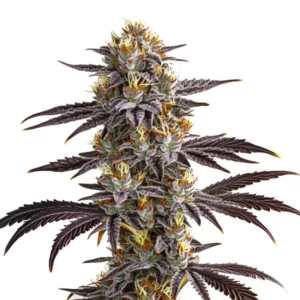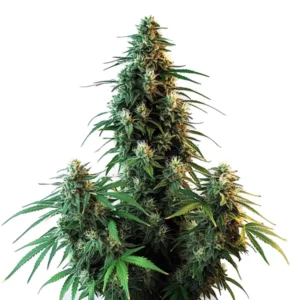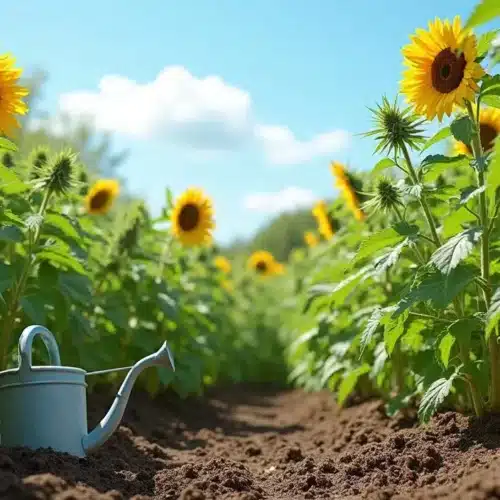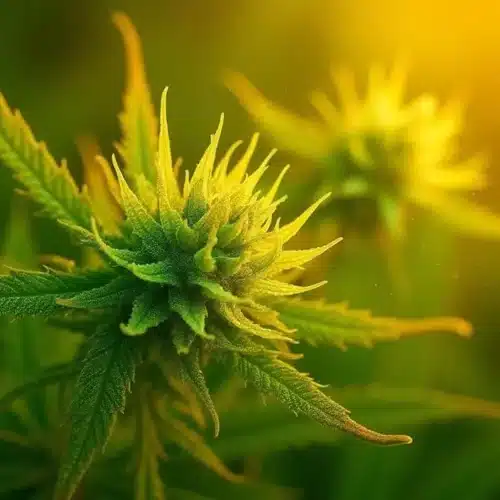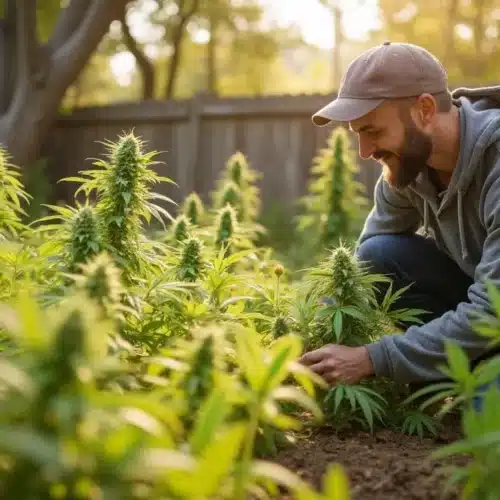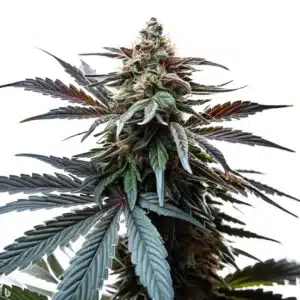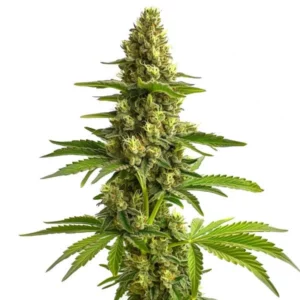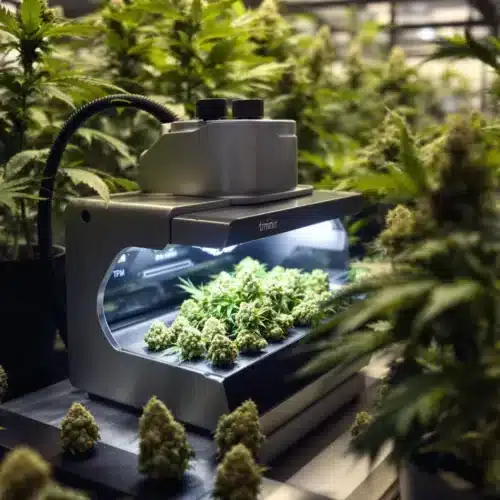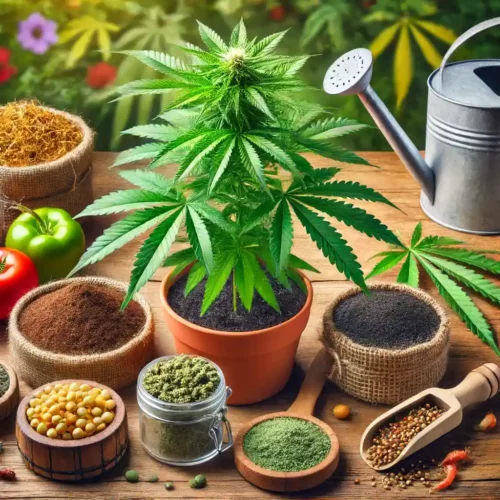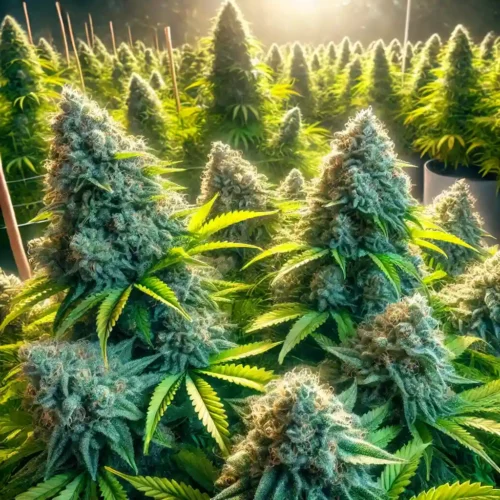When it comes to drying cannabis outdoors, careful planning and precise execution are essential for preventing unwanted mold after harvest. Mastering the art of outdoor drying can be both a rewarding and enjoyable process, combining scientific precision with a touch of nature’s spontaneity.
Outdoor drying offers a natural, energy-efficient method that brings its own set of challenges and rewards. Whether you are a seasoned cultivator or new to the practice, the strategies discussed here will help you achieve a healthy, potent yield while avoiding pitfalls that may affect quality.
Drying Cannabis Outdoors: Challenges of Outdoor Drying (Humidity, Pests)
The process of drying cannabis outdoors is affected by unpredictable elements. High humidity and pest infestations can create an environment where mold is likely to develop. Maintaining proper environmental conditions is fundamental when drying cannabis outdoors, as small variations in weather can have a significant impact on the outcome.
Weather fluctuations and local climate factors require constant vigilance. Growers must be prepared to adapt their techniques quickly if conditions turn unfavorable. This proactive mindset is key for anyone who asks, can you dry cannabis outdoors successfully, even when faced with challenges that seem overwhelming.
Humidity Issues and Weather Variability
Moisture is a major enemy during the outdoor drying process. The high humidity levels often encountered in many regions can slow down the drying speed, creating pockets where mold can grow undisturbed. A deep understanding of your local climate patterns helps in planning the best drying schedule and positioning for your plants.
Effective humidity management requires a combination of strategic timing and the use of natural ventilation. Adjusting the drying period to coincide with drier parts of the day and employing protective coverings can mitigate some risks. Weather forecasts and microclimate observations become your best allies.
Pest Infestation and Environmental Intruders
Outdoor drying exposes your crop to potential pests such as insects and birds. These intruders can damage delicate buds or introduce contaminants that may lead to mold formation. Physical barriers, such as nets or screens, serve as a first line of defense while allowing enough airflow for proper drying.
Monitoring for pest activity is a daily task during drying. The use of natural repellents and timely intervention ensures that the buds remain intact and free from unwanted visitors. Attention to detail at every stage can make all the difference in preventing mold.
Promos & Deals
Setting Up an Outdoor Drying Area (Shade, Airflow)
Choosing the right spot for drying cannabis outdoors is as important as tending to the plants themselves. A well-selected area that provides ample shade and proper airflow will accelerate the drying process and help maintain the quality of your harvest.
Finding a balance between sun exposure and shade is necessary to prevent overheating or damp conditions that invite mold. Strategic placement in an area shielded from harsh weather can protect your crop while allowing gentle air circulation.
Choosing the Perfect Location
Location selection begins with assessing your surroundings. The chosen area should offer natural protection from sudden downpours and extreme sunlight while ensuring a consistent airflow. Positioning your drying setup near natural wind corridors can speed up moisture evaporation.
Utilizing elevated platforms or hanging lines can also contribute to the overall effectiveness of the drying process. These methods create space around the buds, reducing the risk of moisture accumulation. Thoughtful planning of your drying station will yield benefits that extend well into the curing phase.
Managing Sunlight and Ventilation
Sunlight is a double-edged sword when drying cannabis outdoors. While light is necessary for maintaining the integrity of the trichomes, direct, intense sunlight may dry the buds too quickly and compromise their potency. A balanced exposure that emphasizes gentle, indirect sunlight is ideal.
Ventilation plays an equally important role. Ensuring continuous airflow prevents stagnation and lowers the humidity around the plants. Innovative setups such as adjustable drying racks or portable windbreaks can provide the controlled environment needed to keep mold at bay.
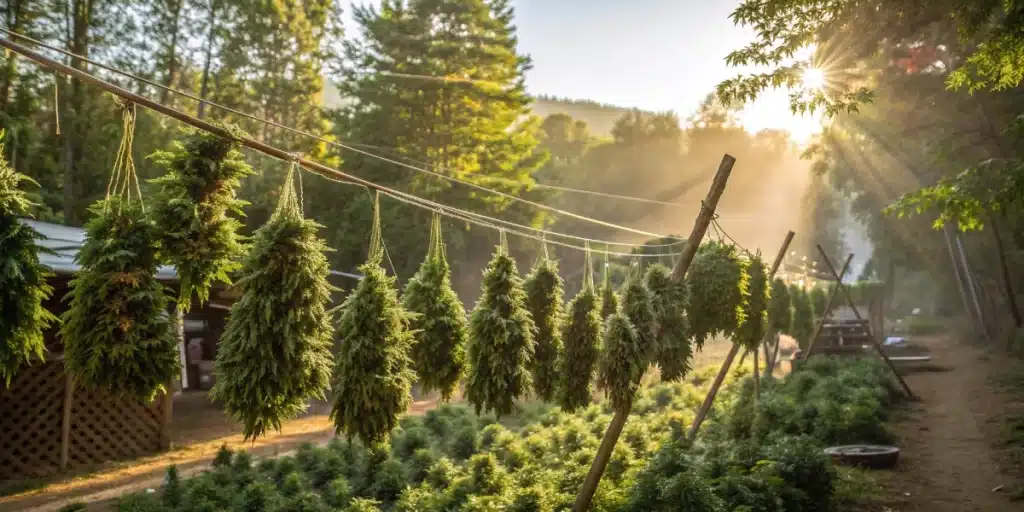
Drying Cannabis Outdoors: Monitoring Drying Buds (Preventing Mold)
Close supervision of your drying cannabis outdoors is indispensable. Regular monitoring allows you to identify early signs of mold or mildew and take swift action before the problem escalates. Observing the texture and color changes in your buds provides essential clues regarding their moisture level.
Implementing a daily check routine with attention to detail is highly recommended. This hands-on approach ensures that any potential issues are detected early, preserving the quality and potency of your harvest.
Identifying Early Signs of Mold
Visual inspection remains the most effective method for early detection. Look for white, fuzzy spots or a slight discoloration that indicates the onset of mold. It is important to differentiate between harmless natural variations in the buds and the subtle beginnings of fungal growth.
Temperature and humidity readings can serve as indicators of potential problems. A sudden spike in moisture levels or a drop in temperature might signal conditions ripe for mold development. Keeping a log of these observations over the drying period will help in making timely adjustments.
Regular Checks and Preventative Maintenance
Adopting a disciplined approach to monitoring means setting aside dedicated time each day to inspect your drying setup. Even a brief check can reveal significant changes. Using tools such as hygrometers and thermometers assists in keeping track of environmental conditions.
Taking preventative measures, such as rearranging the drying racks for better airflow or moving the buds to a slightly different location, can prevent mold from taking hold. This proactive care is essential for ensuring that your carefully cultivated crop remains pristine throughout the drying process.
When to Finish Drying Indoors (If Needed)
Sometimes, unpredictable weather conditions can necessitate finishing the drying process indoors. Recognizing the signs that indicate a transition is needed is critical for maintaining bud quality. A swift move indoors can prevent overexposure to humidity and unwanted contaminants.
Shifting the drying process indoors offers more control over temperature and humidity, providing a safe haven if the outdoor environment becomes unstable. Assessing the condition of your buds and the local forecast allows you to decide when to bring your crop inside.
Transitioning Techniques for Optimal Drying
Transitioning from outdoor to indoor drying requires careful planning. Begin by moving the buds gradually to minimize shock and maintain an even drying pace. A staged transfer can help the buds adjust without compromising their delicate structure.
Using mesh screens or temporary drying racks indoors can simulate the outdoor airflow while protecting against sudden moisture spikes. These techniques ensure that your crop continues to dry evenly until it reaches the desired state.
Creating a Controlled Indoor Environment
Once indoors, the focus shifts to maintaining a consistent environment. Aim for a temperature range that promotes slow, steady drying without drying out the buds too quickly. Humidity control remains a top priority during this phase.
Employing dehumidifiers and fans can help maintain the optimal balance. Regular monitoring and minor adjustments keep the process on track, ensuring that each bud dries uniformly and remains free from mold. Indoor drying is not only a backup plan but also a useful method for achieving precision when nature’s unpredictability takes over.
Drying Cannabis Outdoors: Curing the Buds After Drying
Curing is the final stage that elevates the quality of your harvest. Proper curing enhances flavor, potency, and overall smoothness while reducing harshness. The care taken during drying sets the stage for an excellent curing process.
Ensuring that your buds are completely dry before starting the cure is paramount. A well-cured product reflects the attention paid to every step, from initial harvest to the final drying stage. The curing process refines the buds and preserves their natural aromas and cannabinoids.
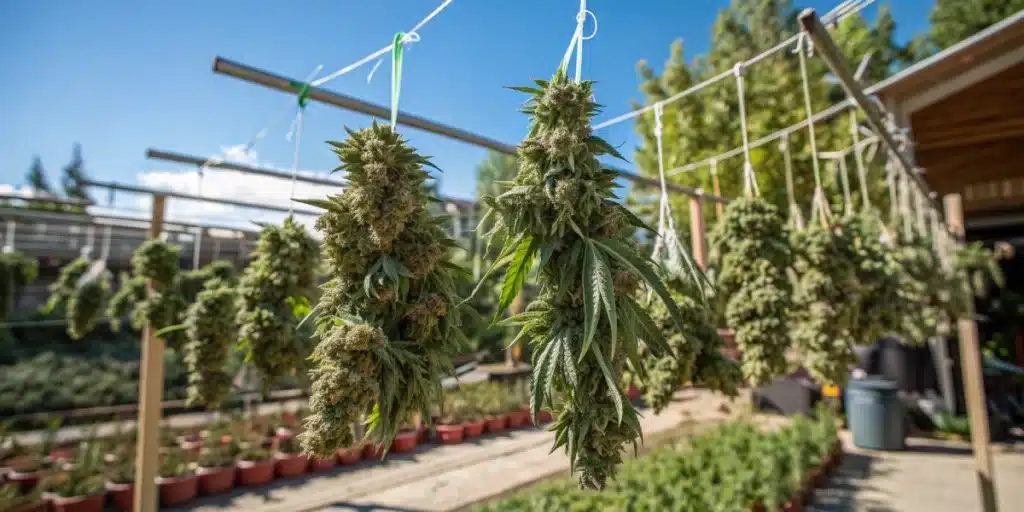
Benefits of a Thoughtful Curing Process
Curing allows the chemical processes within the buds to complete gradually, ensuring that the end product has balanced potency and flavor. This period also helps to mellow any sharp, fresh characteristics that may result from the drying phase.
A dedicated curing space with controlled temperature and humidity enables your buds to reach their full potential. Embracing the curing process with patience and precision will pay dividends in both quality and user satisfaction.
Steps to Cure Properly
After the drying stage is complete, the buds should be placed in airtight containers. Opening the containers regularly during the first few weeks helps to release any excess moisture and prevents the formation of condensation. Monitoring the curing environment is as essential as monitoring during drying.
Consider incorporating traditional techniques such as burping the containers at set intervals. This practice ensures that your buds receive a consistent exchange of air, aiding in the development of their optimal flavor profile. A well-executed cure is the hallmark of a truly refined product.
Outdoor Drying Best Practices and Additional Strategies
Beyond the basics, experienced growers often experiment with innovative techniques to further enhance the outdoor drying process. These strategies include adjusting drying times, using natural inhibitors, and integrating modern technology with traditional practices.
Integrating new approaches into your routine may help you refine your skills and consistently yield high-quality buds. Experimentation in small batches allows you to pinpoint the best combination of techniques that suit your local environment and specific strain characteristics.
Fine-Tuning Drying Durations
Fine-tuning the duration of drying sessions based on environmental factors can improve outcomes significantly. Observing the gradual changes in bud density and moisture content provides valuable feedback for optimizing drying times. Adjustments based on real-time conditions prevent prolonged exposure to high humidity.
Using timers and environmental sensors can streamline this process. By correlating data from these devices with visual inspections, you can tailor your drying periods more precisely. This technical yet intuitive approach ensures that each batch is dried at its peak potential.
Natural Additives and Protective Measures
Some growers incorporate natural additives to help deter mold without compromising the purity of the buds. Organic sprays and herbal infusions have been reported to offer additional protection during the drying phase. Such measures, when used sparingly, can add an extra layer of security against fungal growth.
For instance, using mild essential oils on nearby plants or incorporating natural repellents in the drying area can ward off pests and inhibit mold formation. Techniques like these complement traditional methods and provide a holistic approach to outdoor drying.
Incorporating Technology with Tradition
Modern technology can seamlessly integrate with time-tested outdoor drying techniques. Using wireless sensors to monitor humidity, temperature, and airflow offers real-time insights into the drying environment. These devices empower growers to make quick, informed adjustments.
Blending digital tools with natural drying practices ensures that your crop benefits from both innovation and tradition. Whether you are adjusting ventilation or timing your drying sessions more precisely, technology acts as an invaluable ally in maintaining ideal conditions.
Occasionally, a quick check on the ambient conditions might prompt you to remember that even during peak drying times, one might wonder, can you dry cannabis outdoors safely? With the right precautions and monitoring, the answer is a resounding yes.
Drying Cannabis Outdoors: Integrating Strains and Unique Characteristics
Every cannabis strain has its unique drying and curing needs, making it important to adapt techniques accordingly. Some strains exhibit faster drying times, while others benefit from prolonged exposure to controlled conditions. Recognizing these subtle differences helps in tailoring your process.
For instance, a strain with a high resin content might require a more cautious drying approach to preserve its aromatic compounds. By integrating these nuances into your routine, you not only prevent mold but also maintain the integrity of the buds.
Strain-Specific Adjustments
Strains such as Super Boof Auto often demand a lighter touch during the drying process due to their delicate structure. Monitoring their drying pace and adjusting the airflow accordingly can make a significant difference in the final product quality. Each strain has a personality that reflects in its texture, aroma, and potency.
Even experienced growers find that adapting techniques to suit different strains enhances overall outcomes. Tailor your drying strategies to the specific needs of each batch to preserve the unique characteristics that make each strain special.
Balancing Aesthetics and Efficiency
While efficiency is a key objective, many growers also appreciate the aesthetic qualities of their harvest. The drying phase is not only about reducing moisture but also about preserving the visual appeal of the buds. A well-dried batch will exhibit vibrant colors and a robust structure that hints at its potential.
By focusing on both functionality and presentation, you ensure that your buds are as attractive as they are potent. Combining scientific precision with a touch of artistry creates a drying process that is both effective and enjoyable.
Drying Cannabis Outdoors: Maintenance and Long-Term Strategies
Maintaining the drying area and refining your methods over time are important for achieving consistent results. A well-maintained space will yield better quality buds and reduce the risk of recurring issues. Regular upkeep, paired with strategic improvements, creates a reliable environment for your crop.
Long-term strategies include seasonal adjustments, investing in durable equipment, and keeping up with evolving best practices. By taking a proactive stance, you can adapt your methods to overcome any new challenges that arise with changing weather or crop variations.
Regular Cleaning and Equipment Checks
A clean drying space minimizes the risk of mold and pest infestations. Regular cleaning of racks, nets, and storage containers prevents the build-up of debris and potential contaminants. Incorporate cleaning routines into your schedule to ensure that every drying cycle starts on a fresh note.
Periodic equipment checks help identify wear and tear that might impact performance. Replacing or upgrading components as needed guarantees that your drying setup remains effective over multiple harvests.
Adapting to Seasonal Changes
Outdoor drying is inherently tied to seasonal variations. Adjusting your schedule to align with seasonal weather patterns can significantly enhance drying efficiency. For instance, drier months might allow for longer outdoor sessions, whereas more humid periods may necessitate shorter durations or an early move indoors.
Understanding these seasonal shifts and planning accordingly ensures that your buds receive the optimal drying environment at all times. Tailoring your methods to the natural cycle of the seasons is both a smart and sustainable approach.
Faqs
How do I know when my buds are ready to be moved indoors?
Observing the buds closely for changes in texture and moisture is key. When the outer parts feel dry yet the interior remains slightly soft, it is time to transition indoors. Maintaining a controlled indoor environment during the final phase helps lock in quality.
What are some effective natural methods to prevent mold during outdoor drying?
Using natural repellents, such as organic essential oils and herbal infusions, along with proper spacing and airflow, can significantly reduce the risk of mold. These methods complement your regular monitoring and environmental control practices.
Are there any specific strains that require unique drying adjustments?
Absolutely. For example, strains like Godfather OG Seeds and Blue Dream Seeds may have distinct drying needs based on their resin content and bud density. Tailoring your technique to each strain’s characteristics ensures that every batch dries evenly and retains its full potential.



